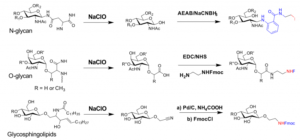Our proprietary process is based on a controlled oxidation using sodium hypochlorite (household bleach). Most natural glycans occur as glycoconjugates, in which glycans are attached to other biomolecules such as proteins or lipids. Due to the high oxidation state of glycans, they are much more resistant to oxidative degradation than proteins and lipids including their linkages with glycans. As a result N-, O-glycans from glycoproteins and glycans from glycosphingolipids are quickly released by bleach with different reducing end structures and can be easily derivatized with fluorescent tags (Fig. 1).
